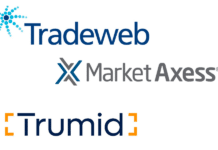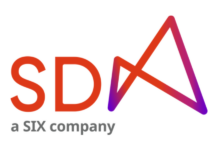MarketAxess has reported its Q2 results for 2022, including a record composite corporate bond market share, estimated at estimated 20.2%, up from 17.8% in Q1 2021 with estimated shares of US credit for investment grade (IG) and high yield (HY) at 20.9%, up from 19.1% in the prior year also hitting a record.
Speaking with analysts on the firm’s earning’s call, president and chief operating officer (COO) Chris Concannon noted the firm had done well in support of portfolio trading (PT), but that demand across the industry for PT had plateaued.

“We had a record quarter, and we were able to execute 330 trades over that quarter and saw our market share of electronic PTs grow,” he said. “We do think that while portfolio trading plays a role in transferring of risk in the marketplace it’s a very expensive trade to perform both in terms of time while managing the trade but also in terms of spread that is ultimately paid. We do see [portfolio trading] has flattened out as a percent of overall TRACE volumes, so we’re not seeing any growth even at times when it was less volatile than the second quarter. But despite the volatility, in the second quarter, we saw clients still make use of portfolio trading tools and also use our platform for portfolio trading.”
MarketAxess reported US$23 billion in portfolio trading volume in Q2, up from US$4 billion in 2Q21 and $14 billion in 1Q22.
A key differentiator that the firm had identified in the PT space was the need for analytics around the trading protocol to help traders assess liquidity around individual names, and estimate the overall price of a portfolio trade would be pre-trade, in order to assess whether or not it would be preferable to use a list trade instead of a full portfolio trade.
“Analytics that help clients decide whether or not to put on a portfolio trade and also what parts of their overall list should be traded as a list or as a portfolio, we’re seeing a lot of demand for,” he said. “Both as real time pricing of the portfolio, but also analytics on how to perform the portfolio trade.”

Rick McVey, CEO of MarketAxess added, “It’s been pretty flat for four quarters in a row at 5.5% or so of TRACE. That’s a change from where we were a year ago and in our conversations with dealers and clients, it’s much more difficult to manage the risk in a large portfolio trade today than it was eight or nine months ago. And that’s reflected in the pricing that’s coming through on portfolio trade.”
He also noted that lower overall bank revenues for the quarter had been hit by the reduction in bond issuance, which in turn lowered trading volumes.
“The new issue calendar is way much lower than it had been previously,” he said. “And that clearly is an important catalyst for overall TRACE volumes. So that factor is certainly in the TRACE volume numbers that you see from the second quarter. And we’ve had a pretty big shock to the market with a 15% drop in prices. So, the overall dollar value at work and corporates is lower than it was at the beginning of the year as well.”
At the same time he saw reasons for optimism on the speed of trading based on increased market participation, with new client growth in credit trading, and 40% compound growth rates in trading automation with both dealers and investors.
“So we are optimistic long term, but we’re not surprised with some of the short term headwinds around overall market volumes,” he said.
Concannon added, “We’re hearing from our clients about some of the liquidity challenges, and those liquidity challenges aren’t just in treasuries, we’re also seeing liquidity challenges in credit. That’s why our [all-to-all] Open Trading alternative liquidity solution did actually see some positive yield in the second quarter and gains across many of the different products in terms of overall volumes, but also penetration within those products.”
In its quarterly report, the firm estimated it had created US$238 million in transaction cost savings for clients via Open Trading, with US$439 million in estimated transaction cost savings year-to-date.
McVey ruled out a move into primary markets, which rival Tradeweb has hinted at, saying “It’s not a space that we are currently in and our focus continues to be almost exclusively around secondary trading and growing out protocols and products and market share there … workflow solutions around the new issue process are not currently an investment area for the company.”
Overall revenues for the quarter were US$182.2 million, up 3%, while expenses reached US$97.4 million, up 9%. The firm has 1,935 total active clients, up 5%, and saw total trading average daily volume (ADV) of US$35.4 billion, up 43%, driven principally by a 64% increase in US Treasury ADV to US$22.7 billion and a 15% increase in total credit ADV to US$12.3 billion.
In IG credit, the firm took commission revenue of US$75.1 million, including US$23.5 million in fixed-distribution fees, which was lower by $2.7 million, or 3%, compared to $77.8 million, including $21.4 million in fixed-distribution fees, in the prior year. Higher platform trading volumes and an increase in estimated market share were more than offset by lower average fees per million
For other of credit markets, commission revenue of US$82.3 million (including $8.1 million in fixed-distribution fees) which had increased US$7.4 million, or 10%, compared to US$75 million (including US$7.9 million in fixed-distribution fees) in the prior year. The increase was driven principally by strong estimated market share gains across other credit products, slightly offset by lower average fees per million.
US high-yield estimated market share was 17.3%, up from 14.3% in the prior year on ADV of US$1.8 billion, representing an increase 22%. Eurobonds market share was estimated at 15.1% on ADV of $1.5billion, up 2%. Excluding the impact of foreign currency fluctuations, Eurobonds ADV would reportedly have increased approximately 13%.
Emerging markets (EM) ADV was US$2.8billion, up 13%, with estimated market ADV down 10%. Excluding the impact of foreign currency fluctuations, emerging markets ADV would have increased approximately 14%.
Municipal bond trading volume was also reported as a record, with volume at US$23 billion and ADV of $371million, respectively, driven in part by an approximate 170-basis point increase in estimated market share.
The firm saw total rates commission revenue of US$6.1 million increased $2.4 million, or 65%, compared to the prior year, driven by a 64% increase in US Treasury ADV to $22.7 billion on strong estimated market share gains.
The combined information and post-trade services revenue of US$18.5 million decreased $1.2 million, or 6%, compared to the prior year. This was apparently principally driven by the impact of currency fluctuations and planned customer attrition in connection with the Regulatory Reporting Hub integration.
©Markets Media Europe 2025













